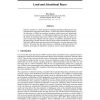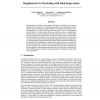124
Voted
NIPS
2008
15 years 2 months ago
2008
For supervised and unsupervised learning, positive definite kernels allow to use large and potentially infinite dimensional feature spaces with a computational cost that only depe...
126
click to vote
NIPS
2008
15 years 2 months ago
2008
We present a mixture model whose components are Restricted Boltzmann Machines (RBMs). This possibility has not been considered before because computing the partition function of a...
107
click to vote
NIPS
2008
15 years 2 months ago
2008
Selective attention is a most intensively studied psychological phenomenon, rife with theoretical suggestions and schisms. A critical idea is that of limited capacity, the allocat...
124
click to vote
NIPS
2008
15 years 2 months ago
2008
By attempting to simultaneously partition both the rows (examples) and columns (features) of a data matrix, Co-clustering algorithms often demonstrate surprisingly impressive perf...
125
click to vote
NIPS
2008
15 years 2 months ago
2008
Policy gradient (PG) reinforcement learning algorithms have strong (local) convergence guarantees, but their learning performance is typically limited by a large variance in the e...
135
click to vote
NIPS
2008
15 years 2 months ago
2008
This paper addresses the important tradeoff between privacy and learnability, when designing algorithms for learning from private databases. We focus on privacy-preserving logisti...
126
click to vote
NIPS
2008
15 years 2 months ago
2008
Contours have been established in the biological and computer vision literature as a compact yet descriptive representation of object shape. While individual contours provide stru...
108
click to vote
NIPS
2008
15 years 2 months ago
2008
In partially observable worlds with many agents, nested beliefs are formed when agents simultaneously reason about the unknown state of the world and the beliefs of the other agen...
105
Voted
NIPS
2008
15 years 2 months ago
2008
119
click to vote
NIPS
2008
15 years 2 months ago
2008
Object matching is a fundamental operation in data analysis. It typically requires the definition of a similarity measure between the classes of objects to be matched. Instead, we...


